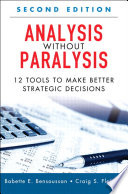

The book emphasizes the importance of simplifying data analysis processes to avoid becoming overwhelmed. It advocates for stripping down complex datasets to their core components, allowing decision-makers to focus on the most relevant information. By prioritizing simplicity, analysts can communicate insights more effectively, leading to quicker and more confident decision-making. The author illustrates this concept with practical examples, showing how organizations that adopt a straightforward approach to analysis can achieve better outcomes and foster a culture of data-driven decision-making. This idea resonates with professionals who often find themselves lost in the sea of data and need guidance on how to distill essential insights.
Continue readingOne of the book's core tenets is the need for insights that drive action. The author argues that analysis should not be an end in itself but a means to inform decisions and strategies. This involves focusing on metrics and data points that have a direct impact on business objectives. The book provides frameworks for identifying which insights are actionable and how to present them in a way that encourages decision-makers to take the necessary steps. By honing in on actionable insights, organizations can avoid analysis paralysis and ensure that their analytical efforts lead to tangible results.
Continue readingThe author discusses various tools and techniques that can enhance the analysis process. From data visualization software to statistical methods, the book provides a comprehensive overview of resources that can streamline analysis. The emphasis is on choosing the right tools that fit the organization's needs and the specific analysis being conducted. The author also highlights the importance of continuous learning and adaptation, encouraging analysts to stay updated with new technologies and methodologies. This idea is crucial for professionals looking to enhance their analytical capabilities and leverage technology effectively.
Continue readingCollaboration is a recurring theme in the book, with the author highlighting its importance in the analytical process. By fostering a collaborative environment, organizations can leverage diverse perspectives and expertise, leading to more robust analyses. The book outlines strategies for encouraging collaboration among teams, including regular brainstorming sessions, cross-functional projects, and open communication channels. The author argues that collaborative analysis not only improves the quality of insights but also enhances buy-in from stakeholders, making it easier to implement data-driven decisions across the organization.
Continue readingThe concept of iterative analysis is central to the book's approach. The author advocates for a cycle of analysis, implementation, and feedback, where insights are continuously refined based on real-world outcomes. This iterative process allows organizations to adapt their strategies and analyses in response to changing conditions and new information. The book provides practical tips on how to establish effective feedback loops, ensuring that insights are not static but evolve over time. This idea is particularly relevant for professionals in dynamic industries where agility and responsiveness are key to success.
Continue readingEffective communication of insights is critical for ensuring that analyses lead to action. The author discusses various strategies for presenting data in a clear and compelling manner, emphasizing the importance of storytelling in data presentation. By framing insights within a narrative, analysts can engage their audience and make the data more relatable. The book also covers the use of visual aids and infographics to enhance understanding. This idea is vital for analysts and decision-makers who need to convey complex information to diverse audiences, ensuring that insights are understood and acted upon.
Continue readingThe final key idea revolves around the importance of measuring the success of analytical initiatives and learning from failures. The author encourages organizations to establish metrics for evaluating the impact of their analyses and to adopt a mindset of continuous improvement. By analyzing what works and what doesn’t, organizations can refine their analytical processes and strategies over time. This idea is essential for fostering a culture of accountability and growth, enabling professionals to learn from their experiences and enhance their future analyses.
Continue reading